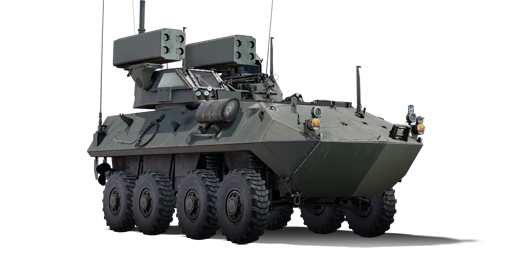In September 1982, the United States Marine Corps (USMC) adopted General Motors' submission in the LAV (Light Armored Vehicle) program as the LAV-25 in order to improve the strategic mobility of the USMC divisions. With enhanced mobility, there was a concern of these units out-speeding the anti-aircraft defense units, especially against short-range, low-altitude aircraft. As such, in 1991, the USMC sought for a low-altitude air defence system capable of supporting a rapidly moving LAV (also known as Light Armored Infantry (LAI)) battalion. The LAV-25 was chosen as the basis to keep pace with the unit, and configuration tests began in 1992 with a rapid-firing rotary cannon and Stinger missiles. By 1996, the Light Armored Vehicle - Air Defence (LAV-AD) was put into production and the USMC received 17 units by 1997.
Introduced in Update "Wind of Change", the LAV-AD meets the expectation set in its name. It is a lightly armoured vehicle intended for air defence. As such, the armour is basically non-existent, with even heavy machine guns having the capability of penetrating through the side armour. However, the LAV-AD has the provisions to provide close air defence with its Stinger missiles and rotary cannon. The Stinger missile helps reach out to far away enemy targets, ideally under 3 km away for the best effect of either hitting the target or tracking it enough that the enemy is forced to perform evasive manoeuvres that may break off their attack run. If the enemy closes within the Stinger's minimal arming distance, the rotary cannon could help provide the last-ditch effort to knock down the enemy aircraft before it can destroy the LAV-AD or its teammates. For a more ground-attack based role, the LAV-AD can also be equipped with M247 rocket pods in place of its Stinger missiles to complement its HVAP ammo belt that could help take care of lightly armoured targets.
















